Wisconsin Is Now a Republican Oligopoly
Election results reveal Democrats now start all elections with a ten percent disadvantage.
The 2010 election gave Republicans control over all three branches of Wisconsin government: the governorship, the state senate, and the assembly. They took advantage of this control to redistrict legislative districts to give themselves a built-in advantage in all future elections. The recent election results offer a chance to measure the size of this advantage and its likely effect on the state.
For a party wishing to gain an electoral advantage through redistricting, the basic strategy is to pack a select number of districts with very high proportions of voters favoring the other party. This creates the opportunity for a larger number of districts with a majority of voters favoring the party doing the redistricting. In this article, I look at the effectiveness of this strategy in Wisconsin.
An alternative approach sometimes taken is to add up the total votes for candidates from each party and compare the results. With the increasing number of districts in which one or the other party does not bother to field a candidate, such totals have become less meaningful; the party with no candidate receives no votes. Even when the party does field a candidate in a district that favors the other party, a candidate regarded as doomed finds it hard to mount an effective campaign. By contrast, every vote in a state-wide race is equally valuable in determining the outcome, whether cast in a competitive district or one in which one or the other party has a lock.
I then estimated the tipping point, the percentage of the statewide votes that would cause a majority of the Wisconsin House of Representatives, state senate, or assembly to flip from Republican to Democratic or back again. Here are some conclusions from this analysis.
1. Democrats now start with a ten point handicap
To win control of the state senate or assembly, the average Democratic candidate would have to win 55 percent of the vote statewide compared to 45 percent for the average Republican candidate. To put this another way, if we assume Wisconsin is evenly divided between Democratic and Republican voters, the Democrats would have to convince 5 percent of the Republican voters to switch.
I have dubbed this extra Republican advantage the “Democratic handicap.” In athletic terms, it would be as if, before posting the final score, the referees took 5 percent of the total points from one team and gave it to the opposing team.
The Democratic handicap calculated from November’s election is similar to that calculated from the 2012 election between Barack Obama and Mitt Romney. In that election Obama would have needed to win over 54 percent of Wisconsin votes to win a majority of the Wisconsin senate and assembly districts.
2. This handicap is largely the result of deliberate gerrymandering
Recently, both in Wisconsin and nationally, there has been a rash of articles arguing that the Republican advantage is due largely to the concentration of Democratically-inclined votes in cities rather than a deliberate policy of gerrymandering districts. Fortuitously, the 2008 presidential election allows us to test this argument.
Following the 2000 census, neither party controlled all three branches of government. After attempts to agree on redistricting proved futile, the job was turned over to the courts. The 2008 election was run with court-drawn districts.
As can be seen from the graph on the right, under the court-drawn districts Republicans did start with an advantage, but one much lower than today’s. Rather than today’s ten-point handicap, Democrats started behind by only a point or two. The built-in handicap was too small to keep control of the legislature from switching back and forth during the last decade. That will be very different now and for the foreseeable future.
3. Meaningful electoral choice is disappearing in Wisconsin
Introductory economics texts start by describing perfect competition with many players. The resulting competition quickly eliminates opportunities for permanent advantage. If the class has time, it then turns to real-world economic structures. These include oligopolies where there are only a few players. One strategy oligopolists might be tempted to use is to divide up the market to reduce competition. Imagine that Walmart and Target were the only retailers and each avoided territories where the other was strong.
Politically, Wisconsin looks increasingly like an oligopolistic market. The parties themselves seem to have increasingly learned the futility of contesting most districts. In November’s election, fewer than half of Wisconsin voters lived in assembly districts where they were given a choice between candidates from both parties. Two-thirds (64 percent) of Democrats in the incoming Assembly will have won election with no Republican opponent. Similarly, almost half (46 percent) of Republicans taking office next month were not challenged by a Democrat. In other words, over half the members of the new Wisconsin Assembly had no opponent from the other party.
Competitive districts are increasingly rare. If the 2008 election results are adjusted so that the state-wide vote was evenly split between the two parties, in over a third of US House and state Senate and Assembly districts the winner would have received 54 percent or less of the vote. Such close margins would have made these seats very tempting for the other party. With enough resources, the right candidate, and a bit of luck, such seats might be flipped. In the most recent election, however, the proportion of such competitive districts dropped from one in three to around one in eight.
Given Republican rhetoric supporting the benefits of competition in theory, the party’s efforts to stifle competition in practice is striking.
To those who believe that society benefits when people engage only with these who agree with them, this may be regarded as good news. For those of us who believe that exposure to new and unfamiliar ideas—including the discipline of defending one’s own ideas from those who disagree—is a valuable experience, this seems limiting.
4. The Democrats’ problem goes beyond candidates
After every disappointing election result, there is a rash of post-mortems. One very predictable route is to blame the candidate. Blaming the candidate eliminates any need to rethink a party’s strategy.
As the chart shows, Burke performed about as well in US House and Wisconsin Senate and Assembly races as did the Democratic candidates for those seats. The vertical axis shows the percentage of votes Burke received in the district. The horizontal axis shows the vote percentage the Democratic candidate for the district received. Only districts where both parties fielded candidates are shown. Districts that fall on the diagonal line are ones where both Burke and the district candidate got the same percentage of the vote. In districts above the line Burke got a higher percentage; in those below her percentage was lower. Sometimes she did a bit better and sometimes a bit worse, but overall her performance was about what would be expected from a Democratic candidate in Wisconsin in 2014. Unlike Barack Obama in 2012, she did not run ahead of her party, but she also did not run behind it.
The next graph compares the Democratic percentage for state senate and assembly candidates in 2012 and 2014. Unsurprisingly, the overall percentage voting for Democrats was lower than in 2012.
5. Why the election results are bad news for nearly everyone
In the long run, this situation is bad for Democrats, for Republicans, for Wisconsin and for the region:
- Bad for Democrats: It sets up a conflict of interest between individual office holders and the cause of gaining a legislative majority. Since the majority of Democratic legislators either had no Republican opponent or an opponent with little chance of winning, their personal interest may lie more in keeping the Democratic base happy than in reaching out to people who supported the governor and other Republicans in the recent election. Even if they recognize the need to expand the Democratic tent, they will have had little personal experience in how to do it.
- Bad for Republicans: In the short run, the gerrymandered districts are very good for Republicans. For the foreseeable future, the can maintain control of the legislature even if a majority of voters turn against them. By being beholden to a minority of voters, however, it seems likely they could grow out of touch with the concerns of the majority.
- Bad for Wisconsin and the Milwaukee region: The present electoral scheme puts the emphasis on issues that divide Wisconsin—and divide Milwaukee from its suburbs—rather than ways to address needs across the state and the metro region.
An alternative districting scheme that emphasizes competitive districts could help create incentives to find common ground. Parts of four Congressional districts include portions of the Milwaukee metropolitan area: First (Paul Ryan), Fourth (Gwen Moore), Fifth (James Sensenbrenner), and Sixth (Glenn Grothman). Combining either the first three or the last three leads to a competitive “super-district,” which could then be subdivided into three competitive districts, incorporating parts of Milwaukee and its suburbs. It seems likely that successful candidates for these new seats would be people who offer a vision that benefits the whole area.
Data Wonk
-
Life Expectancy in Wisconsin vs. Other States
 Dec 10th, 2025 by Bruce Thompson
Dec 10th, 2025 by Bruce Thompson
-
How Republicans Opened the Door To Redistricting
 Nov 26th, 2025 by Bruce Thompson
Nov 26th, 2025 by Bruce Thompson
-
The Connection Between Life Expectancy, Poverty and Partisanship
 Nov 21st, 2025 by Bruce Thompson
Nov 21st, 2025 by Bruce Thompson


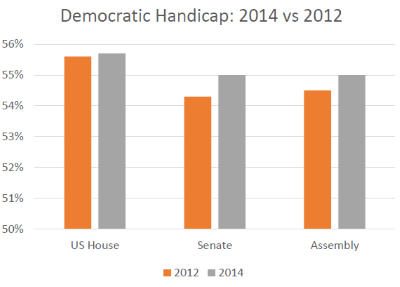
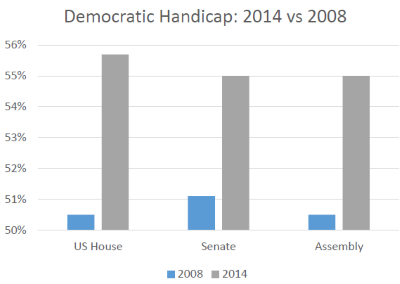
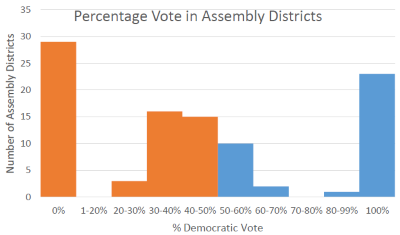
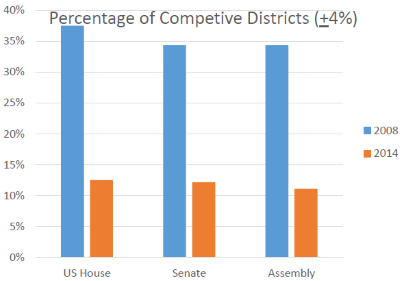
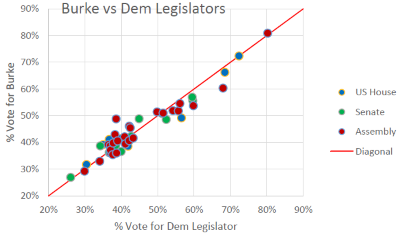
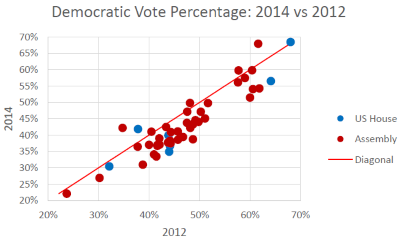




















Heck of a great article. One little quib. The “three branches” of government are legislative, judicial, and executive. The house and senate are not branches, they make up the legislative branch. Just my two cents.
This is not surprising when everyone looks at the mismanagement that put the state and Milwaukee in disastrous position. Walker has fixed that and the dems just cannot figure it out. The Left bases everything on their hatreds instead of taking a look at what the average working family needs to succeed in their lives. Hatred blinds them. I have never taken the time to hate, it is too exhausting and never produces anything of value. Confucious;’If going for Revenge, dig two graves”.
WCD, you can’t be serious? You spew hatred here constantly. You badmouth liberals, the left, Flynn, Barrett, Chisholm, Abele, etc., on a near-daily basis. You call them names and insult them over and over and over again. Hate is in almost every single one of your posts here. It appears hatred has blinded you as well.
If WCD says it, you can believe it (or so he claims). I absolutely believe he hates all those people.
I mean just this week he called all of the stupid and racist, among other things. It’s hard not to read that as hating them.
I’m not a fan of WCD but just because one person believes another group is racist doesn’t mean he hates that group. Can you say that the “Dixi-crats” of a half century ago were racist? Probably but that doesn’t mean you hate them.
About the article…this really comes done to rigging districts which both parties do as much as they’re able to and it really waters down what some would claim is a democracy. I think the most extreme example is a district in Maryland that connects a left leaning area to a heavily conservative area by means of a 1000 foot hwy effectively silencing the left leaning constituents. The Supreme Courts (both State and Federal) really need to step up to restore more balance.
The district I referenced above is Maryland District 2
Casey I am basing my conclusion of countless posts of his over an extended period of time, not one or two posts. He routinely makes hateful and vitriolic comments about his favorite targets: liberals, the left, Barrett, Abele, Flynn, and Chisholm.
Current Republicans and many Democrats are bought and paid for by corporations. Most state laws being implemented by the Republican legislature and approved by Walker were written by corporations and supplied by ALEC. Welcome to 21st Century Oligarchy and fascism. This is duplicated across the country in other states. Fascists may have been beaten in WWII, but they are back in great force and control now.
The downward spiral will continue and great damage will be done that may collapse the country.
Is ALEC still a force David? I know they were, but I was under the impression that their influence has waned, at least somewhat. Not the case?
Oh-ho….more name calling and not even using the right name. I would hardly call what neo cons are doing anywhere near fascism considering that fascism’s aim was a controlled centralized economy based on nationalism.
Oligarchy? Yes, deffinitly. (I know I spelled that wrong but what can you do?)
Fascinating article. You know it’s good when the Wisconsin Conservative Digest slings mud all over it in an attempt to distract.
Name one conservative in office who is against tons of corporate money. One! When Russ Feingold was in office he and, amazingly, John McCain tried to solve this. Well that endeavor sure has been shut down. Shameful.
In regard to re-districting, look at Austin. That’s all you need to do. The Republicans are surely bent on ghettoizing the votes and eliminating all true representation of anyone who doesn’t look, act, hate like them.